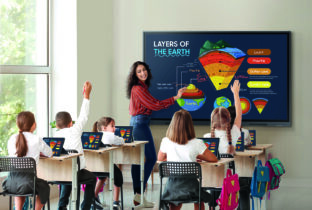Schools around the world faced unprecedented challenges in 2020. As campuses closed, students pivoted to remote learning, and teachers developed creative ways to connect with their classes. Parents and guardians have stepped up to oversee their children’s education at home, while communities have mourned the loss of in-person school as a way for people to connect — and for students to receive nutrition and healthcare.
Here’s a closer look at the challenges educators have faced during the pandemic, and how the changes they’ve made and the new technology they’ve introduced will strengthen the future of education:
Technology needs
When schools began to close their doors at the beginning of the pandemic, many districts gathered the funds to purchase an ed tech device for each of their students. As a result, 1:1 computing policies became the norm for school districts throughout the United States.
Fund your remote learning initiative
Learn how to create, present and secure grants for your remote learning technology needs. Download Now
But the crisis revealed technology gaps, as some districts were able to adopt a remote learning model, while others — which didn’t already have 1:1 computing policies in place — were forced to cancel classes.
Ensuring every student has their own tablet or laptop keeps schools prepared for future shutdowns — whether due to a natural disaster or another public health crisis. Using 1:1 computing also provides access to digital learning resources, so all students benefit from enhanced digital literacy in the classroom.
Finding new ways to connect
When schools switched to remote learning, teachers lost the ability to see their students on a daily basis. They had to find new ways to connect — using videoconferencing, interactive assignments and comment features on platforms like Google Classroom. District administrators have worked with teachers on redefining student engagement for remote learning. Many educators have also started communicating more closely with parents and guardians, many of whom have been overseeing students’ education at home.
Once they return to the classroom, teachers will have more ways to follow up if a student is absent or struggling, and students may feel more comfortable reaching out when they need help.
Equity issues
Widespread school shutdowns have also highlighted accessibility issues across the country. Even if they have the devices they need, many students lack reliable broadband access at home, making it impossible to attend virtual classes via videoconferencing or participate in other synchronous online learning. Some students with disabilities may also lack the resources they need to participate. And students who don’t have anyone available to help them at home may struggle to use the remote technology by themselves.
Newly aware of these equity gaps, many districts are working to level the playing field by offering technical support, providing LTE-enabled tablets and Chromebooks and adapting special education lesson plans for remote instruction.
Community impact
School closures deepened everyone’s appreciation for all that schools do for children. For many students, schools provide much more than education, including nourishing meals, healthcare and counseling. Going to school connects students with their peers and supportive, caring adults. During the pandemic, district leaders have found creative means of providing remote students with these essential services. Some districts served to-go meals, while others provided telehealth. With these alternative solutions in place, schools are in a stronger position to cope with future challenges.
While online school probably won’t remain the norm, students, teachers and districts now have a training ground for digital learning. Ultimately, the challenges of 2020 motivated school districts to be resilient, creating adaptable ways to keep their students engaged and learning, whether they’re at home or in the classroom.
Do you need to secure funding for your remote learning initiative? Find out how in our free comprehensive guide. And if you’re a teacher struggling to adapt to a remote eduction model, here are seven tips to enhance Chromebook-based lesson plans.








